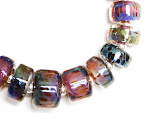When you turn on your kiln, it will automatically ramp up to the Set Point temperature. If you are batch annealing, this should be set to match room temperature and you will immediately pick a preset program for batch annealing and run that program (ramp up to 950 over 2 hours, etc.)
If you are garage annealing, pre-pick the Program you want to run later and set your Set Point to your desired garage annealing temperature (I set mine 20F lower than my annealing temperature to compensate for the spiking of the temperature when you open and close the kiln door). Hours later, run the program after you finish your last piece. This controller does not have a "skip" function.
Set Point
Set point is turned on automatically when you turn the kiln on. This is your garaging temperature. If you batch anneal, this should be set at room temperature.
To program Set Point:
Press SEL once
Press UP ARROW until it shows your garaging temp (I garage 20 degrees lower than annealing temp)
Wait 20 sec and your kiln will ramp up as fast as it can
ProgramsYou can store two programs in the PXR3. SV1-SV4 is Program 1 and SV5-SV6 is Program 2. You may re-program your kiln while the set point is ramping up.
To program Program 1:
Press & Hold SEL until you see P
Press DOWN ARROW (a couple of times) until you see SV1
Press SEL
Press UP or DOWN ARROW to select the temperature (e.g.950F)
Press SEL
Press DOWN ARROW once to 7N1R (length of time to Ramp up to 950F)
Press SEL
Press UP or DOWN ARROW to select the length of time to Ramp up (0:10 – 10 mins)
Press SEL
Press DOWN ARROW once to 7N1S (length of time to Soak at this temperature)
Press SEL
Press UP or Down ARROW to select the length of time to soak at 950F
Press SEL
Press Down ARROW to SV2
Press SEL
Press UP or DOWN ARROW to select temperature you will ramp down to (750F)
Press SEL
Press DOWN ARROW once to 7N2R (length of time to Ramp down to 750F)
Press SEL
Press UP or DOWN ARROW to select the length of time to Ramp down to 750F (2:30)
Press SEL
Press DOWN ARROW once to 7N2S (length of time to Soak at this temperature)
Press SEL
Press UP or Down ARROW to select the length of time to soak at 750F (0:15)
You may leave the rest of the segments – SV3, SV4 of this program – at 0 so your kiln will just turn off after 750F. MAKE SURE YOU SELECT PROGRAM 1.
If you want to have a program for, say, boro or batch annealing – do the same thing for SV5 to SV8 which is Program 2.
Running a Program
Press and hold SEL until you see STAT
Press Down ARROW once to PTn
Press SEL once, it will show the last program you ran (1 or 2)
Press Up or Down Arrow to select a different program if desired
Wait 20 seconds for the kiln to go back to current temperature display
Press and hold SEL until you see PROG
Press SEL once, it will show OFF
Press the Up Arrow once, it will show a BLINKING RUN
Press SEL TWICE, it will show a stationary RUN
Your kiln is now running!











































